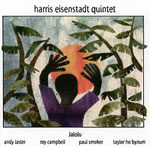Home » Jazz Articles » Album Review » Harris Eisenstadt Quintet: Jalolu
Harris Eisenstadt Quintet: Jalolu
A glimpse at the gallery of instruments immediately reveals its "out of the ordinary" nature'three brass players, a reedsmith and drum kit, but not just any three brass. Smoker, Campbell and Bynum represent a troika of generations and sit comfortably as gifted brass improvisors with highly distinctive vernaculars. Laster may be the odd man out in the horn section, but he holds his own. With Eisenstadt's drums as the sole conventional rhythmic source it often falls on his shoulders to shore up the gaps with cyclic honks and percussive embouchure effects.
The tunes for the date are all originals, influenced by Eisenstadt's desire to incorporate an African style of horn-drum music called hocketing into a Western improvisatory ensemble setting. Translating the tactic can be tricky. Often, Laster will set up a bleating repetitive riff, answered by the brass at various intervals and the leader's cadence-heavy beats. A telegraphic sort of interplay ensues where one horn will start the process and the others will inject their own personal variations in a round robin overlapping lines. Themes surface and recede, but a rough rhythmic sense remains a near constant, even the during the most rambunctious of exchanges between the horns, of which there are many. Sometimes, as on 'Seruba' where Laster and Smoker suss each other out in an overlapping stutter of notes, the quintet is slow in setting the stage. These gradual starts make the entrance of Eisenstadt's funky, frolicsome rhythms all the more galvanizing.
Also enlivening is the manner in which the pieces encourage each man to accentuate the eccentricities of his method of articulation. Bynum resorts to gurgling geysers on 'Boogie On Lenjeno' contrasting with Campbell's stentorian notes, which fall with the feathery near weightlessness of punch card chads. Toward the close the tune the three engage Laster in a loquacious banter of whinnies, snorts, sputters and whispers. Multiple takes of 'Seruba' and 'Jumpin' In' further illustrate the band's workshop approach to tune-smithing.
One minor quibble: Smoker and Campbell are positioned very close to one another in the right channel. While their singular tones and phrasing are usually easy to differentiate, there are points where the proximity becomes a detriment, especially filtered through standard stereo speakers. The tonal bleeding is hardly profuse, however, and the perspicacity of the music more than offsets any extra effort in telling the two apart. Eisenstadt and his wholly personalized assimilation of African influences are definitely worth a listen.
Visit CIMP on the web.
Track Listing
Boogie on Lenjeno; Seruba (take 2); Mwindo; Go (for Adam Rudolph); Jumpin? In (for Eric Dolphy); Seruba (take 1); Ahimsa (Non-Violence) #2; Jumpin? In (for Eric Dolphy) (take 2). Recorded: October 27 & 28, 2003, Rossie, NY.
Personnel
Harris Eisentadt: drums; Andy Laster: clarinet, baritone saxophone; Roy Campbell: trumpet, pocket trumpet, flugelhorn; Paul Smoker: trumpet; Taylor Ho Bynum: cornet.
Album information
Title: Jalolu | Year Released: 2004 | Record Label: CIMP Records
< Previous
St. Louis Spring Scene
Comments
Tags
For the Love of Jazz
 All About Jazz has been a pillar of jazz since 1995, championing it as an art form and, more importantly, supporting the musicians who create it. Our enduring commitment has made "AAJ" one of the most culturally important websites of its kind, read by hundreds of thousands of fans, musicians and industry figures every month.
All About Jazz has been a pillar of jazz since 1995, championing it as an art form and, more importantly, supporting the musicians who create it. Our enduring commitment has made "AAJ" one of the most culturally important websites of its kind, read by hundreds of thousands of fans, musicians and industry figures every month.



















